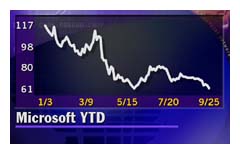|
High Court mum on MSFT
|
 |
September 25, 2000: 9:44 p.m. ET
Court could release update on appeal of Microsoft antitrust case Tuesday
|
NEW YORK (CNNfn) - The Supreme Court made no statement about whether it will hear a direct appeal of the landmark antitrust case against Microsoft Corp. after the Justices met Monday to discuss the case.
The Supreme Court's justices traditionally meet one week before the beginning of a new term to discuss which cases the High Court should agree to review. There are now about 1,600 cases that are pending before the court, only a small fraction of which will be heard.
The High Court might indicate in its orders list due to be released Tuesday at 10 a.m. ET whether it will agree to a direct review of the Microsoft case, rather than sending it first to the U.S. Appeals Court for the District of Columbia. The Supreme Court could also make an announcement before it begins its new session on Oct. 2, antitrust lawyers have said.
The Justice Department and the 19 states suing Microsoft want the Supreme Court to hear the appeal because it would result in a more rapid resolution of the case than if it went to an Appeals Court first. Microsoft (MSFT: Research, Estimates), by contrast, wants the case to follow the standard route of going first to Appeals Court, since that court has been friendly to the company in two previous antitrust matters.
 On April 3, U.S. District Judge Thomas Penfield Jackson concluded that Microsoft had violated federal antitrust law by maintaining its near monopoly over personal computer operating systems by anti-competitive means and by attempting to monopolize the Web browser market. He also found that the software giant violated federal antitrust law by tying its Web browser to its operating system when it released Windows 98. On April 3, U.S. District Judge Thomas Penfield Jackson concluded that Microsoft had violated federal antitrust law by maintaining its near monopoly over personal computer operating systems by anti-competitive means and by attempting to monopolize the Web browser market. He also found that the software giant violated federal antitrust law by tying its Web browser to its operating system when it released Windows 98.
Last June, Judge Jackson issued a final order that requires Microsoft to separate its Windows operating system business from its applications business and bars the software company from engaging in practices that the court found led to the antitrust law violations. However, Jackson's order doesn't go into effect until Microsoft has exhausted its appeals.
After Judge Jackson issued his final ruling, the Justice Department sought to use a 1974 law called the Expediting Act to enable the Supreme Court to hear a direct appeal of the Microsoft case without having the case go first to an Appeals Court. The law allows a federal antitrust case to go directly to the Supreme Court where "immediate consideration of the appeal by the Supreme Court is of general public importance in the administration of justice."
The Justice Department argued that the Microsoft case meets that requirement, and is "especially important to the rapidly developing high-technology sectors, which need to know how they will be affected by the remedies resulting from this case and, more generally, how this Court's antitrust jurisprudence applies to a dominant firm in their marketplace."
Microsoft, by contrast, argued that the Appeals Court would give its appeal more thorough consideration than the Supreme Court would be able to provide, given the size of its caseload and resources available to review documents.
"The benefits of comprehensive review by the Court of Appeals far outweigh whatever time, if any, might be saved by direct review in this court," Microsoft said in a court filing. "The need for soundness in the result outweighs the need for speed in reaching it."
The Expediting Act has been invoked in only two previous cases in the past 26 years. Both of those requests involved an antitrust suit against AT&T (T: Research, Estimates) and its subsidiaries and, in each instance, the Supreme Court accepted direct review. 
|
|
|
|
|
 |

|

